Details of the Kambanos gorge came from the same source as those of the Prines gorge (see ‘Explore!’ Sept 2012) – a guide to Agia Irini and nearby areas (Antonios Plymakis 1994) : “The Kambanos Gorge begins a little further below the village and is full of rocks and wild vegetation. You can walk through it in two hours and you will come out at the village of Moni.” Lynne and I went to explore the gorge one January, shortly before she fell ill. Leaving Kambanos on the connecting road to Moni, we walked less than half a kilometre to where water flooded across the road and into the valley, ending any plans to descend further. Instead, we walked on 2km to the church of Ag. Nikolaus and enjoyed a picnic in the sunshine. 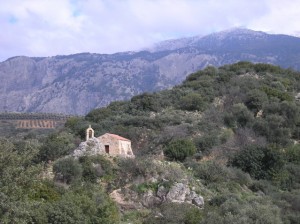 Soon we were joined by a shepherd, feeding his nearby flock and lighting a candle. Chatting to him, Lynne – whose Greek was far more fluent than mine will ever be – asked if there was a path through the gorge? Laughing, he replied, “No, just some olive trees, sheep and goats, and sometimes me.” And how old is the church? “Procthes … “, he told us, literally translated as “before yesterday”, but often used by Greeks to indicate times long ago. Fast forward to late last summer, when friends and I drove 25km from Paleochora to Moni, 4km north of Sougia, parked the car by the cafenion, and caught the early afternoon bus up to Kambanos. The way out of the village is not obvious, but exits steeply from the ‘platea’ by the imposing church of Ag. Konstantinos & Eleni. Keeping south, the road runs alongside the streambed, and after 1.5km reaches a track left, leading to a water pumping station. Although it seems possible to enter the gorge here, it’s not, with gorse, oleanders and other shrubs blocking access.
Soon we were joined by a shepherd, feeding his nearby flock and lighting a candle. Chatting to him, Lynne – whose Greek was far more fluent than mine will ever be – asked if there was a path through the gorge? Laughing, he replied, “No, just some olive trees, sheep and goats, and sometimes me.” And how old is the church? “Procthes … “, he told us, literally translated as “before yesterday”, but often used by Greeks to indicate times long ago. Fast forward to late last summer, when friends and I drove 25km from Paleochora to Moni, 4km north of Sougia, parked the car by the cafenion, and caught the early afternoon bus up to Kambanos. The way out of the village is not obvious, but exits steeply from the ‘platea’ by the imposing church of Ag. Konstantinos & Eleni. Keeping south, the road runs alongside the streambed, and after 1.5km reaches a track left, leading to a water pumping station. Although it seems possible to enter the gorge here, it’s not, with gorse, oleanders and other shrubs blocking access.
Instead, we continued slightly uphill, then turned left along a track leading to Ag. Nikolaus, the church believed to be 15th century, and beautifully situated on the ridge above the gorge. The way into the valley is through a “gate” in the fencing left of, and below the church steps, then working our way steeply down terraces, looking for gaps to find the easiest route. At the foot, another wired ‘gate’ took us into the dry (in summer) Lighias riverbed. 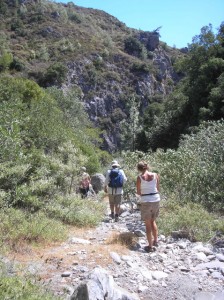 Easily at first, the gorge led us E and then SE, gradually narrowing as we found our way between and occasionally over boulders, but nowhere difficult. Then Michelle, in front, shouted back – “I think we have a problem, a waterfall! ” No water in it, but a vertical drop of some 5m meant either a time-consuming descent with a rope, or a retreat back up the valley. Whilst Rick, Maureen and I considered the options, Michelle went exploring, then shouted ” I have found a way down, not difficult,” and proceeded to show us what will become known eponymously as ” Michelle’s water-slide”, a smooth slab on the left (true) side of the gorge, which drops easily 2m into the riverbed.
Easily at first, the gorge led us E and then SE, gradually narrowing as we found our way between and occasionally over boulders, but nowhere difficult. Then Michelle, in front, shouted back – “I think we have a problem, a waterfall! ” No water in it, but a vertical drop of some 5m meant either a time-consuming descent with a rope, or a retreat back up the valley. Whilst Rick, Maureen and I considered the options, Michelle went exploring, then shouted ” I have found a way down, not difficult,” and proceeded to show us what will become known eponymously as ” Michelle’s water-slide”, a smooth slab on the left (true) side of the gorge, which drops easily 2m into the riverbed.
We met no further problems below here, our progress slowed only by forcing a way through oleanders. On a later visit, we took clippers and (until they grow again) the route should be much easier. At its narrowest, the gorge measures less than 3m wide, with the herb ‘diktamo ‘ clinging onto the sheer walls on either side. Its name name derives from Mount Dikti in eastern Crete, is often used as a drink, and has medicinal qualities in relieving kidney and intestinal problems.
At the end of the gorge, and when the riverbed widens, climb up right to a track heading south. Keep ahead at a junction, and in the distance look out for the unique ‘campanile’ (bell-tower) of what we believe is the former monastery of Panagia Kera. The track leads to the church, surrounded by shady orange and mandarin trees. Climb the campanile (torch advisable), then leave by the rear gate, up to a track which winds first left and then right, to return to Moni, some twenty minutes away.
The walk from Kambanos to Moni gives a fine “mini-expedition”, packing so much variety into a route of around 6 km and three hours. The distance through the gorge below Ag. Nikolaus to Panagia Kera is barely 2km, descending 180m, but feels much longer, with twists and turns in the riverbed providing a surprise around every bend. Yours will not be the first descent, but not many will have been this way before you !

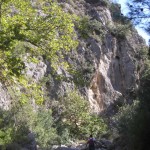
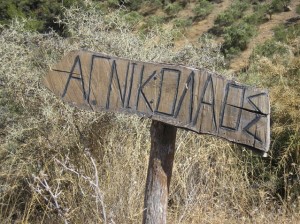

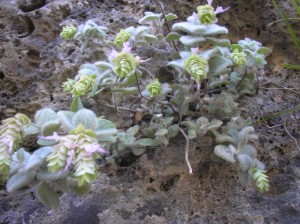
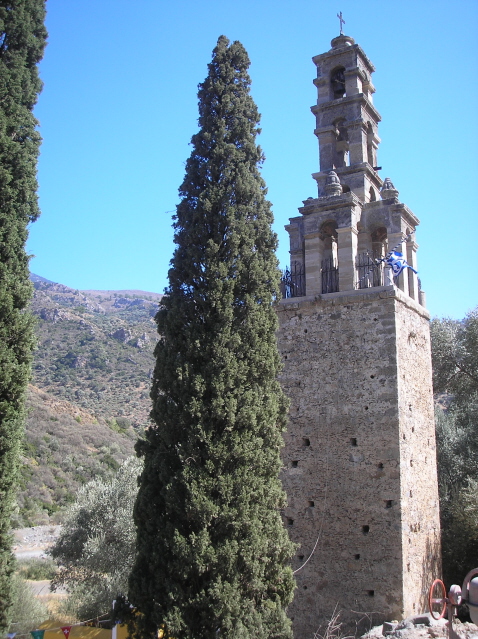

Recent Comments